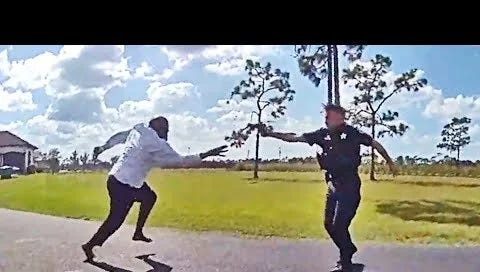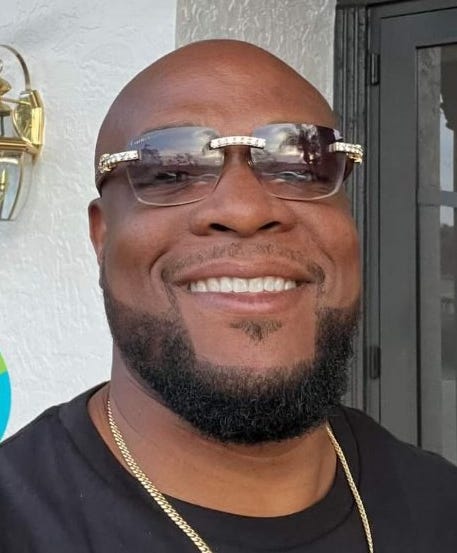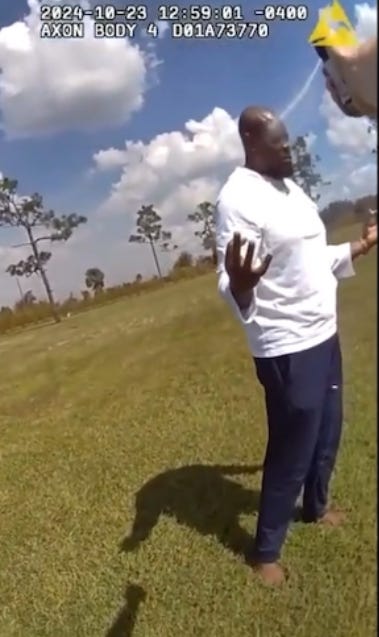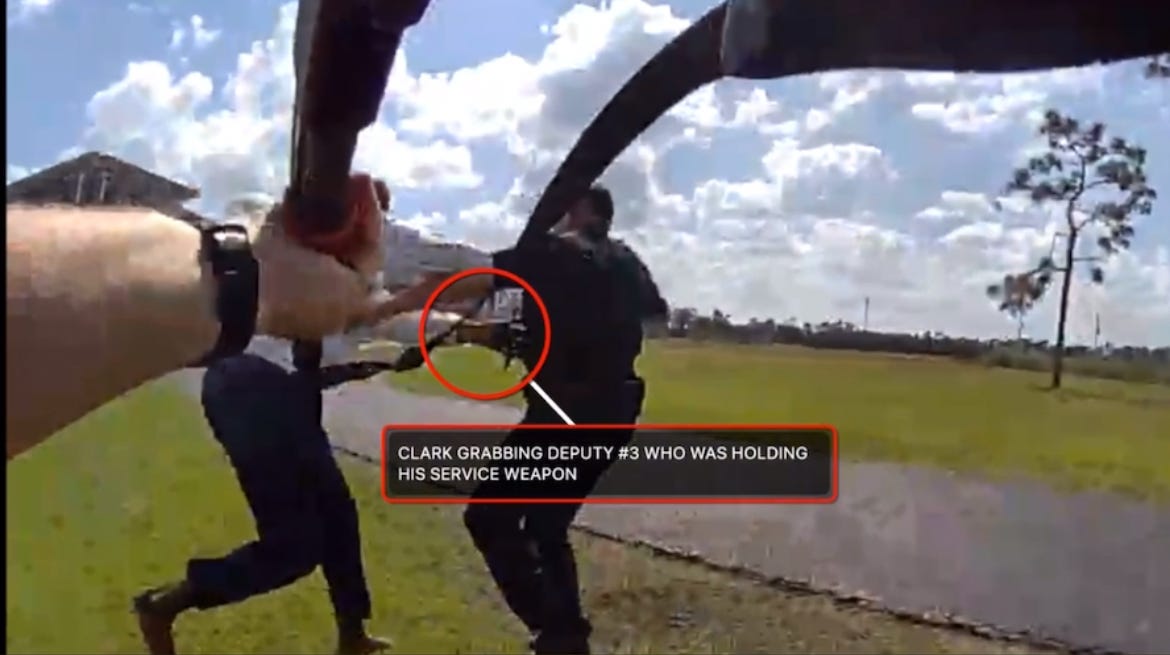The Elroy Clarke case. We know what the narrative will be…
Unarmed black man shot and killed by law enforcement on his own property.
But, of course, there is a lot more to this case.
On October 23, 2024 deputies with the Charlotte County (Florida) Sheriff’s Office were dispatched to a call in reference to a dispute.
The caller (later identified as Elroy Clarke) requested assistance as he wanted law enforcement to remove a man from his residence - that he had allowed to stay there for the last few months.
Deputies investigated and determined that this was a civil dispute and that they were unable to take any law enforcement action.
Something’s not right
During the initial contact with Mr. Clarke it was clear that something was not right.
When deputies asked if Mr. Clarke had any weapons on him - he responded, “I am the weapon.”
He also repeated the phrase, “the peace must be maintained” in a robotic tone.
Warrants
During this interaction deputies learned that Mr. Clarke had outstanding warrants for his arrest.
One of the involved deputies requested backup and verbalized the reasons for this:
Mr. Clarke was a sovereign citizen.
Mr. Clarke was a “pretty big dude”.
Mr. Clarke had also given deputies a false name.
The combination of these factors led to the decision by deputies to not rush the arrest but to allow additional resources to arrive on scene. This was a sound decision.
Arrest
A deputy informed Mr. Clarke that he was under arrest for an outstanding warrant.
Mr. Clarke repeated that his name was “Ben Day” and disputed that his name was “Elroy Clarke”.
Mr. Clarke ordered deputies to leave the property and refused to follow instructions to place his hands behind his back.
As Mr. Clarke ordered deputies to leave he stated, “I am calm, and it’s not about to be”.
A deputy informed Mr. Clarke that force would be used against him (including being “tased”) if he did not comply. This information did not help to achieve the goal of gaining the compliance of Mr. Clarke.
Use of Force
After over three minutes of failed negotiations - force was utilized:
A Taser was deployed - he swatted the probes away.
A second Taser deployment had no effect as well.
OC spray was deployed and had no effect - he wiped it from his face like bathwater.
A “takedown” was attempted but the deputy failed to force Mr. Clarke to the ground.
A third Taser deployment had no effect.
A fourth Taser deployment did cause neuromuscular incapacitation and Mr. Clarke locked up in a standing position.
A deputy successfully pushed him to the ground.
Two deputies attempted to control his arms for handcuffing and were unsuccessful.
During this another deputy deployed the Taser in drive stun mode multiple times.
Mr. Clarke was able to get to a standing position, throwing a deputy from his back like it was a child.
A few more Taser deployments and empty hand tactics were attempted and failed to achieve the desired result.
A deputy then fired three rounds from a bean bag shotgun - that struck but were absorbed by Mr. Clarke like they were Tic Tacs.
This entire exhausting process took place over ten minutes with continual verbal de-escalation, negotiation, and force warnings.
Mr. Clarke then charged at a deputy who hand his handgun out.
The deputy backed away and fired multiple rounds as Mr. Clarke was within a few feet of him.
Despite the rounds striking Mr. Clark - he was still able to grab the deputy’s gun as he attacked.
Mr. Clarke sustained fatal injuries.
Analysis
Deputies had a lawful objective to arrest Mr. Clarke (warrant).
Deputies gave Mr. Clarke clear commands, employed de-escalation tactics, and did not rush the situation as they allowed time for negotiation.
Multiple deputies utilized multiple deployments of four less lethal weapon systems over a ten minute plus interaction. Including three rounds from a bean bag shotgun - that struck Mr. Clarke, but had zero effect.
Mr. Clarke had successfully demonstrated his physical superiority over the deputies and their weapon systems.
So, when he charged at the deputy and reached for the deputy’s gun - deadly force was a reasonable force option.
Had the deputy not utilized deadly force - there is no doubt that Mr. Clarke would have been easily able to overpower, pummel, and disarm the deputy. With this reality in play - deadly force was the only logical option that the deputy had in the moment.
The use of deadly force was objectively reasonable.
Issues
In covering this case - I have witnessed a lot of criticism of the involved deputies. I will address some of those in this section.
Tactics
The main criticism online goes something like this, “four deputies couldn’t take down one guy?”
My typical response, “If only you were there. Hero.”
I do not know why Mr. Clarke was so much more powerful than the four deputies on scene. If you want to critique the empty hand tactics used by the deputies, fine, it’s obvious that none of them were black belts in jiu jitsu. But, he also defeated Taser deployments and bean bag shotguns rounds. Show me the cop that more effective that a bean bag round and I will entertain this line of criticism.
Just Leave
The deputies are being criticized for staying in the fight. It was a warrant. There was no active victim that was in danger. Give Mr. Clarke the option to retain counsel and turn himself in. Regroup and come back later with more resources and maybe when he is not as agitated.
This is all logical - if you know how this case ends. If the deputies were psychic and knew that this would end in an OIS - maybe those other options would have been utilized. But, typically, police do not retreat and reward the behavior of resisting arrest. Especially when it is four cops v. 1 unarmed man.
Mental Health
It’s apparent that Mr. Clarke was in the midst of some mental health breakdown. Why did the deputies not request a mental health clinician to assist with communication?
That is also a reasonable question.
Not every agency has those resources. Also, these types of programs are a great tool for law enforcement. But, even when available - the mental health clinician does not make contact with the individual until the scene is safe. And, this is was never “safe”. If a counselor was on scene - they would have been in a police car, waiting, from a safe distance away.
Final Thoughts
No law enforcement officer wants to use deadly force.
The few who are forced into this terrible situation, by a violent maniac - this stays with them.
I encourage you all to watch the immediate reaction of the involved deputy - after the OIS.
It’s an uncontrolled, raw human reaction and a predictor of the sleepless night he will have…







Great analysis! I couldn’t agree more. The criticism that we should just walk away is the most frustrating. We are paid to enforce the law. If resistance means we back down we will never take anyone into custody. It will be like the dramatic increase in failure to yields that we now experience with the restrictive pursuit policies in place. Our society will be even more of a disaster with crime if cops walked away every time someone resists arrest. This is tragic, but Mr Clarke made choices. Deescalation only works if both parties want it to, it’s not just LE’s job to deescalate.
If you do this job long enough you're going to run into this person and maybe more than once. You're going to deal with the guy who regardless of his size, (and in this case you obviously had a very large man) who is unnaturally strong and resistant to less lethal devices and sometimes even to strikes from Impact weapons and fist hands and feet. I was involved in several during my career, one of them where seven officers were unable to control the subject and multiple activations of the taser were completely ineffective. I say this to illustrate that I've been there, I've done that.
I understand that you don't like the criticism of the officers physical abilities but I'm sorry, I didn't see any physical abilities. At some point they needed to try and take this guy to the ground and in my opinion from the comfort of my couch, they waited far too long and when they did physically engage it was one officer instead of the three or four who were on scene. One officer was trying to control this huge mentally unstable subject while the rest of them stood around. Would a group of officers have been successful where one failed? We'll never know now.
However, there's something that I've noticed over the last five or six years and that is officers seem to no longer "cuff under power" .
As you stated in your breakdown, one of the activations of the taser seem to work as it should have, locking up the neuromuscular system of the subject allowing an officer to knock him to the ground. When that cycle of the taser ended the officers didn't immediately fire another set of darts or continue the activation so that the suspect could be handcuffed while he was still locked up. This was something that my agency used to train for and as a former excited delirium instructor, that's what we taught when dealing with people who were manic and uncontrollable. But my issue is something that has been an issue in law enforcement for decades if not longer and that is officers lack of physical skill when it comes to dealing with a subject particularly when they're on the ground. I am not a big advocate of jiu-jitsu as the main focus, but rather a well-rounded training routine that involves stand up, take down and then ground control.
I'm not trying to slam these officers but this is the type of thing that we need to discuss after an incident goes bad and determine whether something was done wrong and if so what can we do to correct it, determine if something was done right and determine how we can focus on that, or determine if something else should have been done and figure out a way to incorporate that into the training. There shouldn't necessarily be any type of punishment or condemnation but rather decisions on what can be done better in the future and how do we train for that and how do we ingrain that in the officers. Like it or not, every critical incident particularly when a life is taken needs to be broken down after the fact, every single aspect of the incident looked at and inspected and decisions made on what can be done differently, better or what shouldn't be done. That's how police work has been improving their tactics forever.
Now, all of that being said I absolutely agree that this was a 100% Justified use of force by the officers. Regardless of their inability to physically restrain this subject which we're not always going to be able to do, the officers tried everything to deescalate and it was the subject himself who decided he would not be de-escalated. Given the totality of the circumstances, when a large, aggressive and obviously mentally unstable subject who's been able to withstand bean bag rounds, multiple taser discharges, pepper spray and physical restraint charges at you and reaches for your firearm, you have to make the decision, and by the way I made my decision years and years ago, that if a subject charged at me while my gun was drawn then I would have to assume that his reasoning was to take my gun and use it against me, that I would in fact do exactly what this officer did. Now let's hope that the agency and the district attorney supports the officers in this obviously Justified use of force and that the agency uses this incident as a training scenario to fix any problems that they deem were evident during this situation.